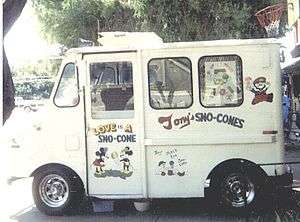Snow cone
|
Snow cone with cherry syrup | |
| Type | Shaved ice |
|---|---|
|
| |
Snow cones are a variation of shaved ice or ground-up ice desserts commonly served throughout North America in paper cones or foam cups.[1] The dessert consists of ice shavings that are topped with flavored sugar syrup.
Depending on the region of North America, the terms "snowball" and "snow cone" may refer to different things. Where the distinction is made, the former refers to a dessert made of finely shaved ice ("like soft fresh snow"), while the latter contains ground-up ice that is coarser and more granular ("crunchy").
History

Industrial Revolution
In the 1850s, the American Industrial Revolution made ice commercially available. Ice houses in New York would commonly sell ice to places like Florida. To transport the ice to Florida, the ice houses would send a wagon with a huge block of ice south. The route to Florida would pass right through Baltimore where children would run up to the wagon and ask for a small scraping of ice. Before long, mothers started to make flavoring in anticipation of their children receiving some ice. The first flavor the women made is still a Baltimore favorite: egg custard. Egg custard was an easy flavor to make as the only ingredients were eggs, vanilla, and sugar.[2]
Theaters
By the 1870s, the snowball's popularity had risen to the degree that in the warm summer months, theaters would sell snowballs to keep their patrons cool. Because of this association with the theater, snowballs were thought of as an upper-class commodity. Signs in theaters instructing patrons to finish their snowballs before coming in to the second act are the earliest tangible evidence of snowballs. In the theaters in Baltimore during the time hand shavers were used to shave the ice. Around the city, snowballs were served on newspaper, but in the classy theaters, butchers' boats were used. In the 1890s, many people started to invent easier ways to make snowballs. In that decade, patents for electric ice shavers were filed.[3][4]
Great Depression and World War II
During the Great Depression and World War II, snowballs became available outside of Baltimore. As snowballs were so cheap, they were one of the few treats that people could afford. This inexpensiveness earned snowballs the nicknames Hard Times Sundae and Penny Sunday. People in need of a job could sell snowballs, as it required little overhead. The treat became more popular during World War II, when all available ice cream was sent to soldiers, creating a need for an icy treat. This newfound lack of competition helped snowballs became popular across the country.[5]
Similar confections

In Hawaii, "shave ice" is similar to snowballs, and is sold in cone-shaped paper cups. "Rainbow," a popular flavor, consists of three colors of syrup chosen usually for their color rather than their taste compatibility. Commonly, a scoop of vanilla ice cream or sweetened azuki beans is first added to the bottom of the cup and is capped with condensed milk.[6]
Vendors in Texas and northern Mexico serve finely shaved ice desserts. Called a raspa, they are usually sold from a roadside stand or trailer. They come in many flavors, including leche (milk and cinnamon) and picosito (the Spanish word for 'spicy' made with lemon and chili powder.)
The dessert ais kacang served in Malaysia and Singapore is another form of shaved ice. Ais kacang was originally served with red beans but now includes various fruits and other sweet toppings.
In Japan they are known as kakigori, and in India it is called a "gola" and usually served on popsicle sticks.
In Britain the term snow cone has been used for a standard ice cream cone topped with (usually vanilla) ice cream, hence the term snow cone. (This is a slightly archaic term however.)
Kala Khatta
Kala Khatta is a syrup made from the jambul fruit in India and some other parts of South Asia. It is primarily used as a flavoring for Indian ice lollipops or popsicles, sold as street food. Crushed ice is formed into a lump by hand and mounted on a stick to make the lollipop. Kala khatta syrup and seasonings such as salt and pepper are then poured on the lollipop.
See also
- Grattachecca - traditional roman snow cone
- Italian ice - water ice
- Granita - a similar Italian ice based sweet snack
- Piragua (food) - the Puerto Rican version
- Slush / Slushie - a shaved ice drink
- Icee - brand-name product
- Slurpee - brand name
- Slush Puppie - brand name
- Sno-ball - New Orleans' version of snow cone
- Snow cream - a cream or snow and dairy-based dessert
References
- ↑ "Carnival Scenes". St. Petersburg Independent. 26 October 1968. p. 6. Retrieved 30 November 2011.
- ↑ Gienow, Michelle. “Cold Comfort: On the Cultural Significance of the Snowball in Baltimore” City Paper. September 18, 1996. Retrieved January 20, 2011.
- ↑ Zay, Libby. "Summer in Baltimore: Snowballs Are the Essential Sweet Treat in Charm City". about.com. Retrieved 25 November 2015.
- ↑ Mayhugh, Jess. "The Snowball: A Baltimore Summer Classic". Serious Eats. Retrieved 25 November 2015.
- ↑ Arnett, Earl “Tracing the Origin, Spread of Snowballs.” Baltimore Sun. 3 Aug. 1977, B1.
- ↑ Interview with Henry Hong about Baltimore summer dessert traditions, on the 1:00 hour of the "Mid-Day with Dan Rodricks" program, July 9, 2009, WYPR
| ||||||||||||||||||||||||||||||||||||||
